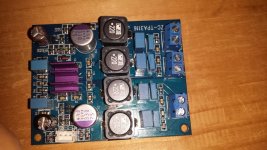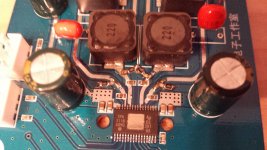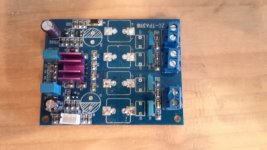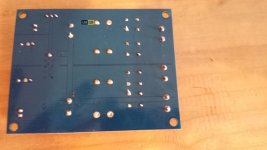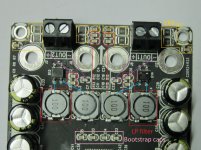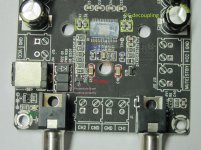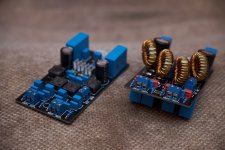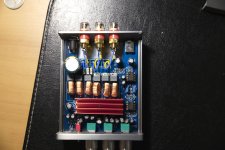It's been awhile since I've posted here (been very busy) but I completed some of the recommended modifications a few months ago to two different 3116 boards (2.0 by Ydbz and 2.0 by ChengZhi). I completed each mod one at a time and compared it back to a stock board by listening to a few songs several times each.
I made the comparisons using Mean Well style 24v SMPS adjusted to 22v. Source was my phone loaded with uncompressed files for easy back and forth. Speakers connected were Polk RTi6 (8ohm). Quick-disconnect terminals on Ydbz made it simple to quickly go back to stock amp for a listen.
For the Ydbz board I used the following parts from DigiKey:
-OSCON 330uF, P16323-ND (Power Caps)
-Panasonic FM 680uF, P12417-ND (Power Cap)
-Epcos Film Cap 0.68uF, 495-4873-1-ND (Output Filter) 7.5mm spacing
-TDK 330pF C0G 0603, 445-9741-1-ND (Bootstrap Snubber)
-10 Ohm Res., RNCP0805FTD10R0CT-ND (Bootstrap Snubber)
For the ChengZhi board:
-OSCON 330uF, P16323-ND (Power Caps)
-Panasonic FM 680uF, P12417-ND (Power Cap)
-Epcos Film Cap 0.68uF, 495-4993-1-ND (Output Filter) 5mm spacing
-Wurth 22uH inductors, 732-1243-1-ND (Output Filter)
-Bootstrap Snubber ???
Overall listening impressions on Ydbz board – Adding OSCON made a difference in bass quality and quantity. Bass was deeper and tighter. I couldn’t hear a difference in mids and highs with OSCON. Pana. FM across power supply input helped reduce power supply noise and slightly improved bass. Film Caps on output filter made little difference at low-mid power levels and had more of an effect at mid-high power levels (sounded less stressed). Bootstrap snubber mod made the most difference when listening to music. The high frequencies were less in the face, reduced in volume (subjective), and smoother overall. I highly recommend this modification as being the biggest improvement (may be related to power supply). I measured the speaker response before and after each mod and found no difference (I don’t yet know how to measure amp response). This was surprising to me as the snubber mod sounded so much different at high frequencies.
For the ChengZhi board – Same as above, but I replaced the stock 10uH inductors with Wurth 22uH inductors to match speaker impedance. Here I measured a difference in the tweeter response starting all the way down at 7K steadily rising to the top end. I was surprised that the output filter changes the response so low. The funny thing is that I could only tell a slight difference between the 10uF and 22uF inductors at high freq. when listening to music (might have been the music I was using). In comparison, the snubber mod was several times more obvious than inductor mod. However, the Wurth inductor definitely helped the bass out (more detailed, smoother, louder). This was most noticeable when driving speakers with more than ~8watts. At higher power levels, the Wurth inductors sounded less stressed than the stock one (saturation?). Below 8watts the difference was less noticeable.
Between the two boards, both sound similar when playing music with the same level of modifications. However, I do prefer the ChengZhi board over the Ydbz board as it is quieter (1/2 as much hiss) when a source is not connected, doesn’t have the turn on/off pops, and is more compact.
This was my first time soldering smt and it required some patience. Size 0603 is way smaller than I expected. Anyone wanting to complete this mod is advised to order larger sized parts if possible. I flung a couple caps off the table and they landed in the carpet. My wife said I looked like a crack head searching for them😀
I made the comparisons using Mean Well style 24v SMPS adjusted to 22v. Source was my phone loaded with uncompressed files for easy back and forth. Speakers connected were Polk RTi6 (8ohm). Quick-disconnect terminals on Ydbz made it simple to quickly go back to stock amp for a listen.
For the Ydbz board I used the following parts from DigiKey:
-OSCON 330uF, P16323-ND (Power Caps)
-Panasonic FM 680uF, P12417-ND (Power Cap)
-Epcos Film Cap 0.68uF, 495-4873-1-ND (Output Filter) 7.5mm spacing
-TDK 330pF C0G 0603, 445-9741-1-ND (Bootstrap Snubber)
-10 Ohm Res., RNCP0805FTD10R0CT-ND (Bootstrap Snubber)
For the ChengZhi board:
-OSCON 330uF, P16323-ND (Power Caps)
-Panasonic FM 680uF, P12417-ND (Power Cap)
-Epcos Film Cap 0.68uF, 495-4993-1-ND (Output Filter) 5mm spacing
-Wurth 22uH inductors, 732-1243-1-ND (Output Filter)
-Bootstrap Snubber ???
Overall listening impressions on Ydbz board – Adding OSCON made a difference in bass quality and quantity. Bass was deeper and tighter. I couldn’t hear a difference in mids and highs with OSCON. Pana. FM across power supply input helped reduce power supply noise and slightly improved bass. Film Caps on output filter made little difference at low-mid power levels and had more of an effect at mid-high power levels (sounded less stressed). Bootstrap snubber mod made the most difference when listening to music. The high frequencies were less in the face, reduced in volume (subjective), and smoother overall. I highly recommend this modification as being the biggest improvement (may be related to power supply). I measured the speaker response before and after each mod and found no difference (I don’t yet know how to measure amp response). This was surprising to me as the snubber mod sounded so much different at high frequencies.
For the ChengZhi board – Same as above, but I replaced the stock 10uH inductors with Wurth 22uH inductors to match speaker impedance. Here I measured a difference in the tweeter response starting all the way down at 7K steadily rising to the top end. I was surprised that the output filter changes the response so low. The funny thing is that I could only tell a slight difference between the 10uF and 22uF inductors at high freq. when listening to music (might have been the music I was using). In comparison, the snubber mod was several times more obvious than inductor mod. However, the Wurth inductor definitely helped the bass out (more detailed, smoother, louder). This was most noticeable when driving speakers with more than ~8watts. At higher power levels, the Wurth inductors sounded less stressed than the stock one (saturation?). Below 8watts the difference was less noticeable.
Between the two boards, both sound similar when playing music with the same level of modifications. However, I do prefer the ChengZhi board over the Ydbz board as it is quieter (1/2 as much hiss) when a source is not connected, doesn’t have the turn on/off pops, and is more compact.
This was my first time soldering smt and it required some patience. Size 0603 is way smaller than I expected. Anyone wanting to complete this mod is advised to order larger sized parts if possible. I flung a couple caps off the table and they landed in the carpet. My wife said I looked like a crack head searching for them😀
Attachments
Fantastic report of actual experience.
Crackhead or no, you're a real help to everyone else, Ian.
Thanks!
Crackhead or no, you're a real help to everyone else, Ian.
Thanks!
Last edited:
Thanks, Quard.
The snubber mod sounded so good on the Ydbz board that I would like to implement it on the ChengZhi board now as this is the amp I use to power my main system. Can I get some opinions on the suggested modification below from someone more experience than me? In the attached picture, is it acceptable to add the snubber mod to the bottom side of the board with the capacitor soldered to the input side of the through-hole pad of the inductor? Then butt solder the resistor to the capacitor and then to ground by scrapping away varnish exposing copper. It is probably best to put right after the bootstrap cap on top, but there is little room for this on ChengZhi. There might be room for 0603 on top, but I’d rather not… Will soldering cap and resistor to inductor input pad cause problems? Bottom location allows use of 1206 size components that are easier to find in the carpet after dropping them from tweezers.
Thanks
The snubber mod sounded so good on the Ydbz board that I would like to implement it on the ChengZhi board now as this is the amp I use to power my main system. Can I get some opinions on the suggested modification below from someone more experience than me? In the attached picture, is it acceptable to add the snubber mod to the bottom side of the board with the capacitor soldered to the input side of the through-hole pad of the inductor? Then butt solder the resistor to the capacitor and then to ground by scrapping away varnish exposing copper. It is probably best to put right after the bootstrap cap on top, but there is little room for this on ChengZhi. There might be room for 0603 on top, but I’d rather not… Will soldering cap and resistor to inductor input pad cause problems? Bottom location allows use of 1206 size components that are easier to find in the carpet after dropping them from tweezers.
Thanks
Attachments
Thanks, Quard.
The snubber mod sounded so good on the Ydbz board that I would like to implement it on the ChengZhi board now as this is the amp I use to power my main system. Can I get some opinions on the suggested modification below from someone more experience than me? In the attached picture, is it acceptable to add the snubber mod to the bottom side of the board with the capacitor soldered to the input side of the through-hole pad of the inductor? Then butt solder the resistor to the capacitor and then to ground by scrapping away varnish exposing copper. It is probably best to put right after the bootstrap cap on top, but there is little room for this on ChengZhi. There might be room for 0603 on top, but I’d rather not… Will soldering cap and resistor to inductor input pad cause problems? Bottom location allows use of 1206 size components that are easier to find in the carpet after dropping them from tweezers.
Thanks
Can't see how that method would cause a problem. Try it and listen - easily removed if needs be.
It's been awhile since I've posted here (been very busy) but I completed some of the recommended modifications a few months ago to two different 3116 boards (2.0 by Ydbz and 2.0 by ChengZhi). I completed each mod one at a time and compared it back to a stock board by listening to a few songs several times each.
I made the comparisons using Mean Well style 24v SMPS adjusted to 22v. Source was my phone loaded with uncompressed files for easy back and forth. Speakers connected were Polk RTi6 (8ohm). Quick-disconnect terminals on Ydbz made it simple to quickly go back to stock amp for a listen.
For the Ydbz board I used the following parts from DigiKey:
-OSCON 330uF, P16323-ND (Power Caps)
-Panasonic FM 680uF, P12417-ND (Power Cap)
-Epcos Film Cap 0.68uF, 495-4873-1-ND (Output Filter) 7.5mm spacing
-TDK 330pF C0G 0603, 445-9741-1-ND (Bootstrap Snubber)
-10 Ohm Res., RNCP0805FTD10R0CT-ND (Bootstrap Snubber)
For the ChengZhi board:
-OSCON 330uF, P16323-ND (Power Caps)
-Panasonic FM 680uF, P12417-ND (Power Cap)
-Epcos Film Cap 0.68uF, 495-4993-1-ND (Output Filter) 5mm spacing
-Wurth 22uH inductors, 732-1243-1-ND (Output Filter)
-Bootstrap Snubber ???
Overall listening impressions on Ydbz board – Adding OSCON made a difference in bass quality and quantity. Bass was deeper and tighter. I couldn’t hear a difference in mids and highs with OSCON. Pana. FM across power supply input helped reduce power supply noise and slightly improved bass. Film Caps on output filter made little difference at low-mid power levels and had more of an effect at mid-high power levels (sounded less stressed). Bootstrap snubber mod made the most difference when listening to music. The high frequencies were less in the face, reduced in volume (subjective), and smoother overall. I highly recommend this modification as being the biggest improvement (may be related to power supply). I measured the speaker response before and after each mod and found no difference (I don’t yet know how to measure amp response). This was surprising to me as the snubber mod sounded so much different at high frequencies.
For the ChengZhi board – Same as above, but I replaced the stock 10uH inductors with Wurth 22uH inductors to match speaker impedance. Here I measured a difference in the tweeter response starting all the way down at 7K steadily rising to the top end. I was surprised that the output filter changes the response so low. The funny thing is that I could only tell a slight difference between the 10uF and 22uF inductors at high freq. when listening to music (might have been the music I was using). In comparison, the snubber mod was several times more obvious than inductor mod. However, the Wurth inductor definitely helped the bass out (more detailed, smoother, louder). This was most noticeable when driving speakers with more than ~8watts. At higher power levels, the Wurth inductors sounded less stressed than the stock one (saturation?). Below 8watts the difference was less noticeable.
Between the two boards, both sound similar when playing music with the same level of modifications. However, I do prefer the ChengZhi board over the Ydbz board as it is quieter (1/2 as much hiss) when a source is not connected, doesn’t have the turn on/off pops, and is more compact.
This was my first time soldering smt and it required some patience. Size 0603 is way smaller than I expected. Anyone wanting to complete this mod is advised to order larger sized parts if possible. I flung a couple caps off the table and they landed in the carpet. My wife said I looked like a crack head searching for them😀
Thank you for the information. I am a bit surprised that you did not observe/hear much differences when changing the inductors. Just curious whether you tried swapping out the the input caps (may be put a higher value ones in place).
Thanks!
Regards,
Just received my Sure TPA3116 and TPA3123 board. Quick initial listening of 3116 board was very pleasing. Temps are normal. Heat sink was about 10C above ambient. Board was ordered from ebay and it had correct speaker terminal markings. Unfortunately it has noticeable turn off pop.
After short listening I removed the heat sink to examine some of the components. In attached pictures I have identified some of the components, but I can't figure out functions for all four transistor looking SMDs near RCA connectors. I was hoping there would be a way to remove the turn off pop somehow. One way could be removing some of the components to make the board more like datasheet standard.
irribeo commented caps c7 and c22 on the output filter here. Removing them might be a good idea.
Anyone else having good ideas for modding this rather decent board?
After short listening I removed the heat sink to examine some of the components. In attached pictures I have identified some of the components, but I can't figure out functions for all four transistor looking SMDs near RCA connectors. I was hoping there would be a way to remove the turn off pop somehow. One way could be removing some of the components to make the board more like datasheet standard.
irribeo commented caps c7 and c22 on the output filter here. Removing them might be a good idea.
Anyone else having good ideas for modding this rather decent board?
Attachments
Did we ever figure out what the bridge rectifier on output does? With all the transistors I am surprised there is still pop issue.
Did we ever figure out what the bridge rectifier on output does? With all the transistors I am surprised there is still pop issue.
Yes.
It's to prevent oscillations outside of the chip that'll blow up the capacitors. It's a "clamp".
Oscillations Sure3116 now will blow up solid electrolytics like the Oscons instead of the ceramic outputcapacitors 😀
Yes.
It's to prevent oscillations outside of the chip that'll blow up the capacitors. It's a "clamp".
You might want to read post #3 in this thread... it is explained what they are for.
Joe L.
YJ Blue Board Capacitors
On the output of the YJ Blue Bord, there are four 1nF capacitors in parallel with the four 0.68uF capacitors.
What is the purpose of these 1nF capacitors?
Are they needed?
On the output of the YJ Blue Bord, there are four 1nF capacitors in parallel with the four 0.68uF capacitors.
What is the purpose of these 1nF capacitors?
Are they needed?
0.68uf with coil and speakers impedance forms low pass filter. 10nF and 1nF with 4.7ohm forms snubber.
You might want to read post #3 in this thread... it is explained what they are for.
Joe L.
Ya, it says what I just said.
Just received my Sure TPA3116 and TPA3123 board
I was hoping there would be a way to remove the turn off pop somehow.
I think one way is to put the board on standby (or maybe mute) when powering on.
I will try this, but first I've to scheck what type of signal to put on the Mute/Stanby connectors of the TPA3116 board.
I'm planning to ask Sure Electronics because there is no documentation on their web site or with the board.
OpterN, replacing the six power caps by four OSCON SEPF 330 mF/25v really inproved the sound on the Sure TPA3116 board.
Last edited:
Just received 2.1 TPA3116D2 amp with this power. It sounds very good to my ears, in comparison to my Indeed DA7498E amp it sounds just as good if not better, (more transparent). But it's channel for the subwoofer I've found somewhat unclear to me. Maybe my subwoofer is not good enough. The amp is connected with Ipad and Microlab Solo 6 speakers. To me it is already sounds good out of the box, but if someone be able to make some kind of mod, that would very interesting to know.
Attachments
Last edited:
finished mods
input capacitor original epcos
output rifarhe426 wima fkp
coils self made
bootstrap rifa rhe
What is the toroid core, 17??
I think one way is to put the board on standby (or maybe mute) when powering on.
I will try this, but first I've to scheck what type of signal to put on the Mute/Stanby connectors of the TPA3116 board.
I'm planning to ask Sure Electronics because there is no documentation on their web site or with the board.
That could be one way of doing it. Let us know how it goes with them. I bought 35V 120uF OSCONs, because I'm planning to use 24V power supply and I don't want to be so close to the maximum voltage rating of the capacitor. Might use two VCC/GND pads to add bigger tank caps later.
I'm wondering is it possible that bridge rectifiers are injecting noise to chip's supply pins during normal operation and causing SQ deterioration. I also read somewhere about diodes making noise, so would it be reasonable to remove diodes that protect the board from reverse voltage, in hopes of getting cleaner current. I like living on the edge. 😀
- Home
- Amplifiers
- Class D
- TPA3116D2 Amp

